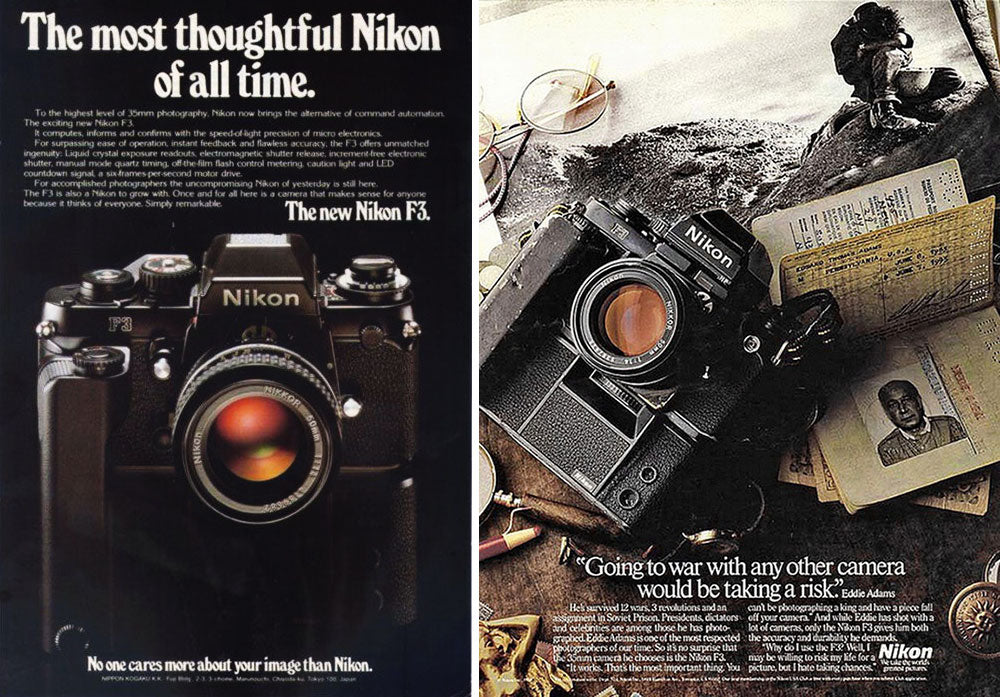
Most people naturally associate the infamous DMC DeLoreon to the 1985 movie “Back To The Future”, & when you look at its futuristic design & sharp edges, it’s hard not to see Marty McFly accidentally hitting 88mph, thrusting him back into 1955. I could talk about Marty & Doc all day long, but I bet right about now you’re asking yourself “When did I sign up for emails from Rotten Tomatoes or iMDB?” Back to the Future was a great film, but we’re here to discuss a different type of film; more specifically, about the Nikon F3 film camera.

What does the Nikon F3 have to dow with the Back to the Future? Let’s go back to the design of the DeLorean.

Giorgetto Giugiaro (pictured above with the Mk1 golf) is an Italian automotive designer & there’s a good chance that you’ll recognize some of his iconic designs. His design work is extensive & impressive, including the Isuzu 117, Maserati Merak, Fiat Dino Coupe, Maserati Ghibli, BMW M1, & of course the DMC DeLeoran, to name a few.

Alongside automobiles, Giorgetto also designed firearms, wrist watches (including the Sieko worn by Sigourney Weaver in Aliens!), and of course, cameras. Giorgetto had his hand in the design of many Nikon cameras, but today we’re talking about the Nikon F3.
The Nikon F3 is a 35mm film single-lens reflex (SLR) camera that was introduced in 1980. It was the successor to the popular Nikon F2 and became one of the most successful and beloved cameras of all time. The F3 was designed for professional photographers and enthusiasts who demanded a high level of control and quality in their images.
One of the most notable features of the F3 is its rugged and durable construction. The body is made from a tough, lightweight alloy that can withstand extreme temperatures and harsh conditions. The camera is also sealed against dust and moisture, making it ideal for outdoor photography. The F3 was tested to withstand a drop of up to five feet without any damage. These features made the F3 a favorite among photojournalists and documentary photographers who needed a reliable camera that could handle the demands of their work.
The F3 also introduced several new features that made it a significant improvement over its predecessor, the F2. One of these features was the introduction of through-the-lens (TTL) metering. This allowed photographers to accurately measure the light that was coming through the lens, providing more accurate exposure readings. The F3's metering system was also very advanced for its time, with a matrix metering system that could read the light from multiple areas of the frame and adjust the exposure accordingly.
Another significant improvement was the introduction of an electronic shutter. This allowed for faster and more accurate shutter speeds, which were essential for capturing fast-moving subjects or for shooting in low-light conditions. The F3's shutter speed range was from 8 seconds to 1/2000th of a second.
The F3 also had a modular design that allowed photographers to customize the camera to their specific needs. There were a variety of viewfinders, focusing screens, motor drives, and other accessories that could be added to the camera. This made the F3 a versatile tool for a wide range of photography styles, from portrait and landscape to sports and wildlife.
Variants: initially, the Nikon F3 was released with the “DE-2 eye level finder” but was shortly followed by the Nikon F3HP (high-point), the Nikon F3HP featured a larger viewfinder, making it easier for users who wore glasses to see their subject.

Another F3 variant was the F3/T, the “t” standing for titanium, it came in a champagne color & weighed 20 grams less than the original F3. You might recognize it as the camera Sean Penn was "using" in The Secret Life of Walter Mitty. It had a titanium back & sides, titanium clad viewfinder’s & titanium top & bottom plate. However the mechanical interior was the exact same as the regular F3.

F3p (the “p” standing for Press) was an option for photo journalists, it featured additional weather sealing, o-rings, & a waterproof shutter release. It did not come with the self timer, film door release lock, or multiple exposure lever.
The Nikon F3H was a high speed variant, meant for sports photography & especially for the 1998 Nagano Olympics in Japan. Paired with the specially produced MD-4H motor drive the Nikon F3H could achieve up to 13 frames per second.
The Nikon F3AF, was an autofocus variant of the F3. It was Nikon’s first camera to feature autofocus when used with either the Nikkor AF-200mm F/3.5 or the Nikkor AF-80mm f2.8 lens.
The F3 remained in production for over a decade, and it was widely regarded as one of the best film cameras of its time. It was eventually replaced by digital cameras in the late 1990s, but it remains a beloved camera among film enthusiasts and collectors. The F3's rugged construction, advanced features, and modular design make it a classic camera that is still capable of producing stunning images today.
Luckily, the Nikon F3 is readily available in the secondhand market, so you won’t need a DeLorean or a flux capacitor to get your hands on one.

